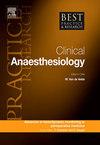Prehabilitation and enhanced recovery after cardiac surgery
IF 2.8
3区 医学
Q1 ANESTHESIOLOGY
Best Practice & Research-Clinical Anaesthesiology
Pub Date : 2025-06-01
DOI:10.1016/j.bpa.2025.08.002
引用次数: 0
Abstract
Cardiac surgery carries substantial risks, particularly for an aging population with increased frailty, morbidity, and malnutrition. Prehabilitation and Enhanced Recovery After Surgery (ERAS) protocols are emerging as essential strategies to optimize patients before surgery and accelerate postoperative recovery. In this review, we explore the role of prehabilitation and ERAS protocols in cardiac surgery, identify the challenges in implementing these strategies, and highlight areas for future research. Prehabilitation involves structured interventions such as physical conditioning, respiratory training, nutritional optimization, psychological support, and lifestyle modifications. While prehabilitation's role in non-cardiac surgery is well-established, its application in cardiac surgery remains less defined due to a lack of high-quality trial data and variability in studies. ERAS protocols, initially designed for colorectal surgery, have been adapted for cardiac surgery to include patient education, early mobilization, multimodal analgesia, and blood conservation techniques. Despite promising evidence regarding prehabilitation and ERAS protocols, the widespread adoption in cardiac surgery has been hindered by patient heterogeneity, limited access, and logistical constraints. The potential benefits include reduced complications, shorter hospital stays, improved recovery, and better patient outcomes. Future research should focus on standardizing prehabilitation protocols, assessing their impact on high-risk populations, and exploring telemedicine solutions to enhance accessibility.
心脏手术后的预适应和增强恢复
心脏手术有很大的风险,特别是对老年人来说,他们越来越虚弱,发病率和营养不良。术前康复和术后增强恢复(ERAS)协议正在成为术前优化患者和加速术后恢复的基本策略。在这篇综述中,我们探讨了康复和ERAS协议在心脏手术中的作用,确定了实施这些策略的挑战,并强调了未来研究的领域。预康复包括有组织的干预措施,如身体调节、呼吸训练、营养优化、心理支持和生活方式改变。虽然预适应在非心脏手术中的作用已经确立,但由于缺乏高质量的试验数据和研究的可变性,其在心脏手术中的应用仍然不太明确。ERAS方案最初是为结直肠手术设计的,现已适用于心脏手术,包括患者教育、早期动员、多模式镇痛和血液保存技术。尽管在康复和ERAS方案方面有很好的证据,但由于患者的异质性、有限的访问和后勤限制,心脏手术的广泛采用受到阻碍。潜在的好处包括减少并发症、缩短住院时间、改善康复和改善患者预后。未来的研究应侧重于标准化康复方案,评估其对高危人群的影响,并探索远程医疗解决方案以提高可及性。
本文章由计算机程序翻译,如有差异,请以英文原文为准。
求助全文
约1分钟内获得全文
求助全文
来源期刊

Best Practice & Research-Clinical Anaesthesiology
ANESTHESIOLOGY-
自引率
0.00%
发文量
37
审稿时长
36 days
 求助内容:
求助内容: 应助结果提醒方式:
应助结果提醒方式:


